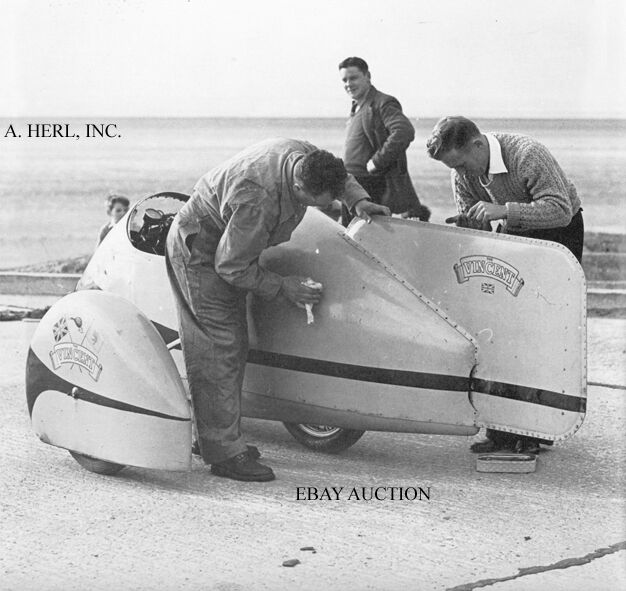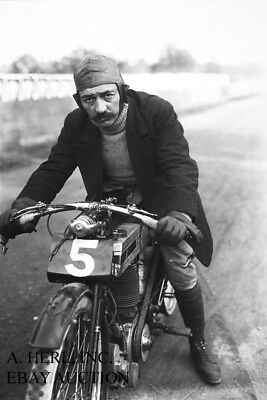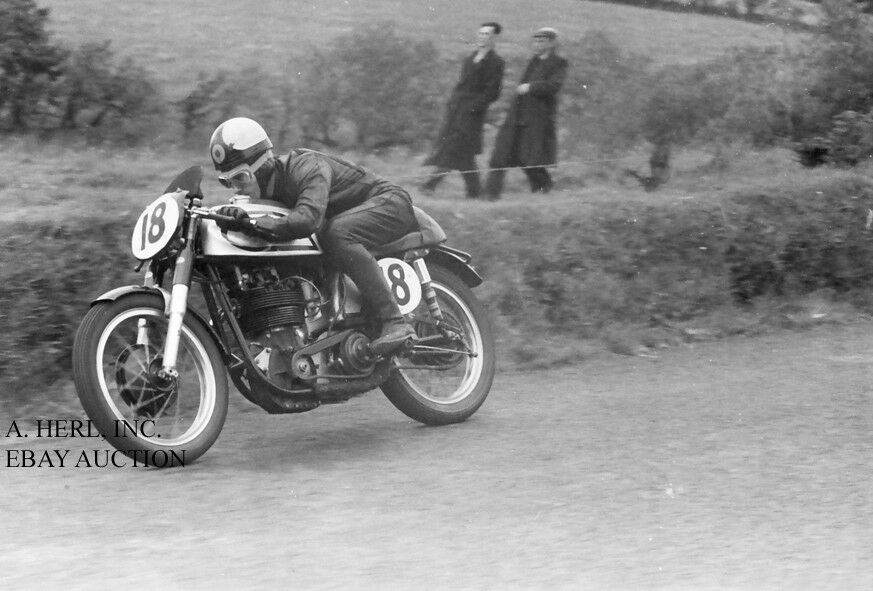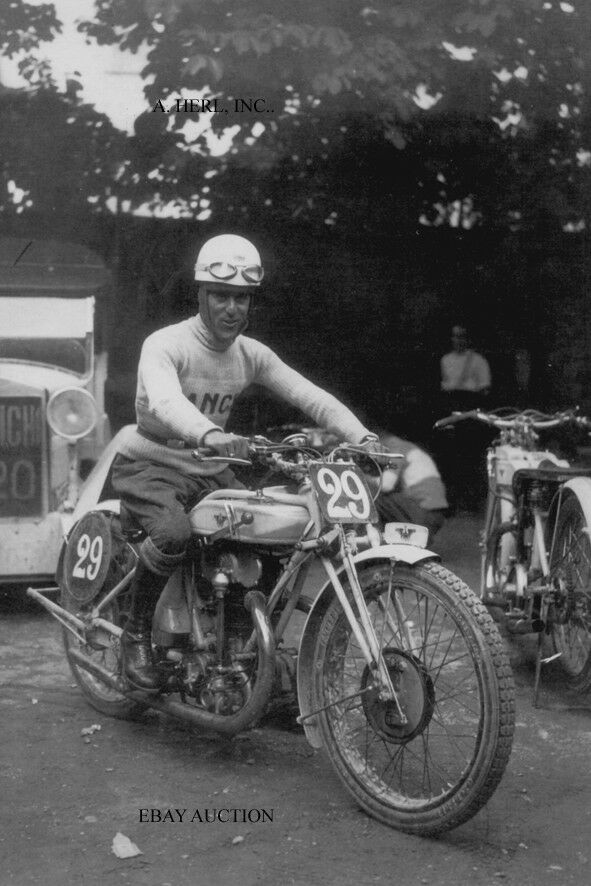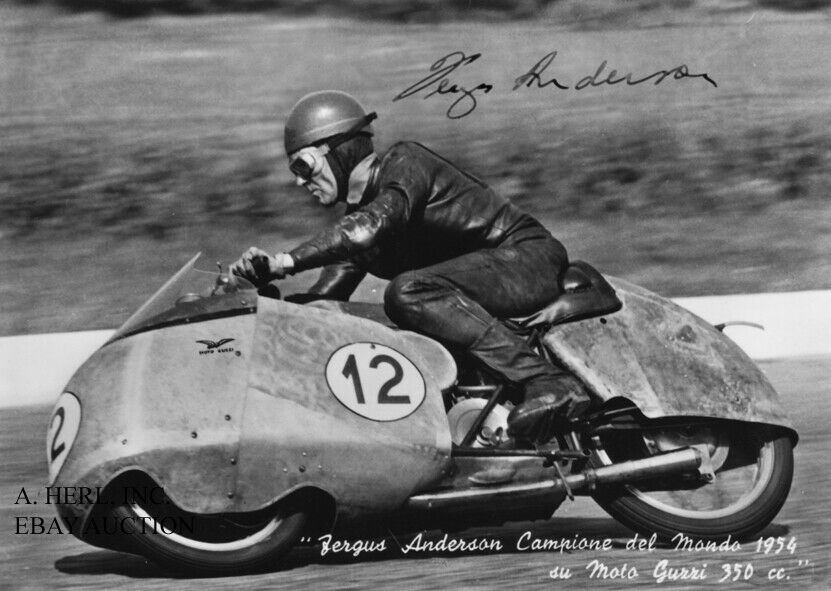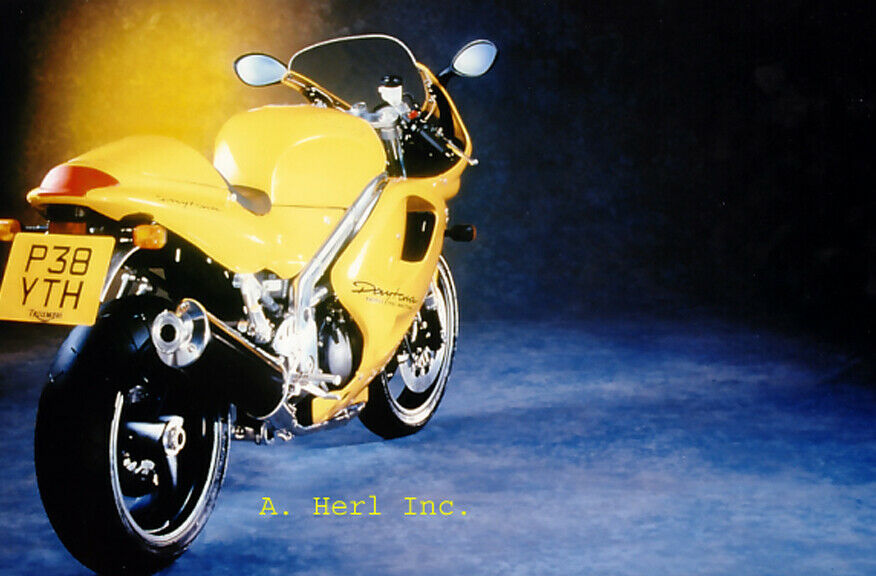-40%
Vincent 163 mph+ world record breaking sidecar & Bob Burns – Pendine 1955 -photo
$ 5.14
- Description
- Size Guide
Description
WEARE
CLEARING OUT OUR ARCHIVES!
A superb and rare image of the magnificent
163.04 mph
(262.39 kmh)
Vincent World Record breaking Sidecar
of
Robert “Bob” Burns
.
He is visible in overalls on the left, polishing the Vincent streamliner’s aerodynamic body shell.
This image was taken during a BBC television recording session on
Pendine beach
in
1955
, a
few months after Bob Burns set on
July 2, 1955
a new
F.I.M. World Sidecar record
of
163.04 mph
(
298 km/h
)
on the
Tram Road
at
Swannanoa
, near
Christchurch
,
New Zealand
. Bob Burns would do a few very fierce runs in front of the camera, after which a journalist also could have a try.
The
163+ mph world record attempt of Burns
has an interesting history. Russell Wright set a 1954
New Zealand
speed record of
140 mph
(
230 km/h
) on a Black Lightning at the Tram Road Speed Trials. At the meeting he met Rapide owner Robert "Bob" Burns who had built a streamliner shell for a sidecar record attempt. They formed a partnership for Bob to supply a streamliner shell for Russell's solo world record attempt, if Russell let him use the Black Lightning for his sidecar world record attempt.
In December 1954 Bob Burns went first and set a new F.I.M. World Sidecar record of
157 mph
(
253 km/h
), up from
154 mph
(
248 km/h
). On
the 2nd of July 1955
, Russell Wright set a new F.I.M. world speed record of
185 mph
(
298 km/h
) on the
Tram Road
at Swannanoa, near
Christchurch
, while Bob Burns upped his sidecar record to
163.06 mph
.
Vincent Motorcycles
, "the makers of the world's fastest motorcycles", began with the purchase of HRD Motorcycles, less the factory premises, by Phil Vincent in 1928. HRD was founded by the British (RFC) pilot, Howard Raymond Davies, who was shot down and captured by the Germans in 1917. Legend has it that it was while a prisoner of war that he conceived the idea of building his own motorcycle, and contemplated how he might achieve that. It was not until 1924 that Davies entered into partnership with E J Massey, trading as HRD Motors. Various models were produced, generally powered by JAP (J A Prestwich) engines. Unfortunately, even though HRD motorcycles won races the company ran at a loss, and in January 1928 it went into voluntary liquidation. The company was initially bought by Ernest Humphries of OK-Supreme Motors for the factory space, and the HRD name, jigs, tools, patterns, and remaining components were subsequently offered for sale again. The legend has it that Philip Vincent dreamt of building a quality motorcycle bearing his own name, just as Howard Davies had, but rather than start from scratch he was advised to start production under an established name. He had built a motorcycle of his own in 1924, and in 1928 had registered a patent for a cantilever rear suspension of his own design. In 1928 Philip Vincent left
Cambridge
University
with an engineering degree and, with the backing of his family wealth from cattle ranching in
Argentina
, acquired the trademark, goodwill and remaining components of HRD from Humphries for £500. The company was promptly renamed Vincent HRD
Co.
, Ltd and production moved to
Stevenage
. The new trademark had "Vincent" in very small letters above "HRD" writ large. After World War 2
Britain
had an export drive to repay its war debts, and the
USA
was the largest market for motorcycles, so in 1949 the HRD was dropped from the name to avoid any confusion with the "HD" of Harley Davidson, and the motorcycle became The Vincent. In 1929 the first Vincent-HRD motorcycle used a JAP single-cylinder engine in a Vincent-designed cantilever frame. The earliest known example extant exists in
Canberra
,
Australia
. Some early bikes used Rudge-Python engines. But after a disastrous 1934 Isle of Man TT, with engine problems and all three entries failing to finish, Phil Vincent (with Phil Irving) decided to build their own engines. Phil Vincent also experimented with three wheeled vehicles, amphibious vehicles, and automobiles. In 1932 the first 3-wheeler, "The Vincent Bantam" appeared, powered by a 293 cc SV JAP or 250 cc Villiers engine. It was a 2.5 cwt delivery van with a car seat and a steering wheel. The Bantam cost £57-10-0 and the windscreen and hood option cost £5-10-0. Production ceased in
1936. In
1931 Phil Irving joined Vincent as chief engineer. His first engine design was an OHV 500 cc single-cylinder engine in 1934. The standard motor was known as the Meteor and the sports motor was the Comet; it was distinguished from earlier Vincent engines of that name by the "Series-A" prefix. There was a TT replica & the Comet Special (basically a TTR with lights, horn etc) , which used a bronze head. The Meteor motor produced 26 bhp (19 kW) @ 5300 rpm. An unusual feature of the valve design for these motors was the double valve guides, and the attachment of the forked rocker arm to a shoulder between the guides, to eliminate side forces on the valve stem and ensure maximum valve life under racing conditions. The Series-A Comet could do
90 mph
(
140 km/h
), but Phil Vincent and his racing customers wanted more. Legend has it that Irving accidentally put a side-view tracing of the Vincent 500 motor wrong way up on top of an equally sized drawing of the same view of the same motor, and saw, moving the tracing so the crankshafts and camshafts coincided, that the result looked like a possible design for a V-twin. This resulted in the 47.5° V twin which appeared in 1936. (The single leaned forward 23.75°.) With 6.8:1 compression, it produced 45 bhp (34 kW). The Vincent V-twin motorcycle incorporated a number of new and innovative ideas, some of which were more successful than others. The Vincent HRD Series A Rapide was introduced in October 1936. Its frame incorporated motorcycling's first "cantilever" rear suspension, which was used on all Vincents produced from 1936 through 1955. Other innovations included foot gearchange instead of hand-operated gearlever, a four-speed gearbox instead of two or three, and a side stand. Pneumatic forks were not to be a Vincent innovation, with both Phils believing girder forks were superior at the time. The Series-A had external oil lines and a separate gearbox. The 998 cc Series A Rapide Vincent cost 0, produced 45 hp (34 kW), and was capable of
110 miles
per hour. The high horsepower meant that the gearbox and clutch did not cope well. In 1937 Phil Irving went to work for Velocette but returned to Vincent Motorcycles in 1943. Vincent primarily made munitions, but Vincent engines were trialled in boats and portable pumps during the war, and the end of hostilities saw Vincent ready to return to motorcycle production. Vincent already looked to
America
for sales, and in 1944 Eugene Aucott opened the first
USA
dealership in the city of
Philadelphia
. Others followed. The Series B Rapide designed during the war and released to the press before end of hostilities looked radically different from the A: now the oil pipes were internal, and the gearbox was part of the engine casting (Unit Construction). The angle between the cylinders was now 50° instead of the 47.5° of the Series A engine. This allowed the use of the engine as a stressed member of the frame, which consisted of an oil-tank spine with the engine hanging below, and the front and rear suspension attached at the ends: . This was considered sensational at the time, and the arrangement was not seen again till the late seventies. The cantilever rear became the most widely used form of rear suspension for motorcycles after 1980, and the use of the engine-gearbox unit as a stressed member became more usual. Brakes were dual single-leading shoe (SLS), front and rear. The 55.5-inch (
1,410 mm
) wheelbase was three inches (
76 mm
) shorter than the Series A, and its dimensions were more like a 500 cc bike of the time. A more modern hydraulic shock absorber and spring assembly later replaced the old twin springs and friction damper. The rear seat was supported by a sub-frame down to the rear frame pivot point, providing a semi-sprung seat with
6 inches
(
150 mm
) of suspension. (Yamaha would rediscover this suspension system nearly 40 years later.) The Series B had a Feridax Dunlopillo Dualseat, and a tool tray under the front. The Series "B" incorporated an inline felt oil filter instead of the metal gauze of the Series "A". Vincent used quickly detachable wheels, making wheel and tyre changes easier. The rear wheel was reversible, and different size rear sprockets could be fitted for quick final-drive ratio changes. The brake & gear shift were adjustable for reach to suit individual feet. The rear mud guard was hinged to facilitate the removal of the rear wheel. These are things taken for granted on modern motorcycles whereas Vincent was a pioneer in their use. From today's perspective, it seems incongruous that Vincent could see the need for, and design, a cantilever rear suspension, as well as incorporate so many other new ideas, yet use Brampton girder forks with friction dampers up front. The two Phils felt that the telescopic forks of the time were prone to lateral flex, so they persisted with girder forks, and did use hydraulic damping in the Series C "Girdraulic" forks. Consider now the use of similar forks on the famous Britten (from
New Zealand
), the current BMW K1200 Series & the Honda Rune. Vincent had sold bikes through Indian Motorcycles dealers in the
US
and in 1948 an Indian Chief was sent to
Stevenage
to be fitted with a Vincent Rapide engine. The resulting hybrid Vindian did not go into production. The 1948 Series C Rapide differed from the Series B in having "Girdraulic" front forks - which were girder forks with hydraulic damping. The "Black Shadow", capable of
125 mph
(
201 km/h
), and easily recognised by its black engine and gearbox unit, and large
150 mph
(
240 km/h
) speedometer, was introduced. The engine produced 55 bhp (41 kW) @ 5700 rpm in Black Shadow trim. The Black Lightning was a racing version of the Black Shadow, with every necessary steel part on it that could be, remade in aluminium, and anything not essential removed altogether, reducing the weight from
458 lb
(
208 kg
) to
380 lb
(
170 kg
). Every bit the racer, it had a single racing seat and rear-set footrests. The 500 cc Meteor and Comet singles were introduced, along with a 500 cc racer, the Grey Flash. The Grey Flash racer used
Albion
gears, for the greater choice of ratios available. The 500 cc bikes used a wet multiplate clutch, while the 998 cc V-twins used a dry, drum-type servo clutch. Most Vincents were painted black. In
1949 a
White Shadow was available, but only 15 were sold, and the option was dropped in
1952. In
1950 16 Red Comets were shipped to the
United States
. There were also 31 of the 1948 Grey Flash built. In 1949 HRD was dropped from the name, and the logo now simply said "Vincent". The term "Series D" was not used by the factory, but was taken as a natural progression by the motorcycling world. With sales falling, Vincent tried building two new high-speed touring models; the fully enclosed Vincent Victor (an upgraded Comet), the Black Knight (an upgraded Rapide) and the Black Prince (an upgraded Shadow). They were poorly received by the public. A short-lived unfaired version of the Black Prince was then produced. There was still a Series D Comet. Sales declined further after the post war motorcycling boom owing to the availability of cheaper motor cars, so not many "Series D" models were made. A growing media association between motorcycles and motorcycle gangs in the late fifties was also giving motorcycling a bad name. It was with the introduction in 1948 of the fully race-prepared Vincent Black Lightning that Vincent produced the most legendary motorcycle of its time. The Black Lightning was advertised as The World's Fastest Standard Motorcycle - This is a fact, not a slogan! - a claim it could have made right up until the release of the 900 cc Kawasaki Z1, 20 years later in 1972. (This same claim had been made in advertising before, for the earlier fastest Vincents) Around 30 Vincent Black Lightnings were built during 1949-52. They were available on special order, selling for ,500. The Black Lightning had magnesium alloy brake backing plates, racing tires on lightweight alloy rims, rear-set pegs, a solo racing seat and aluminum fenders. All these helped trim the Lightning's weight to
380 lb
. (The Black Shadow was
458 lb
) The Black Lightning had higher lift cams, stronger connecting rods, bigger inlet ports, polished rocker gear, steel idler gears, racing carburetors, a manual-advance magneto and could be ordered with compression ratios from 6.8:1 to 12.5:1. The engine was rated at 70 hp (52 kW), and was said to propel the Black Lightning to
150 mph
. The proof of the advertisement's claim came in 1948, when an Indian Motorcycle dealer, Rollie Free, riding the very first Vincent-HRD Black Lightning built, raised the motorcycle speed record to
150.313 mph
(
241.905 km/h
) on
Utah
's
Bonneville Salt Flats
. Initially wearing full leathers, he could only achieve
147 mph
(
237 km/h
), and his leathers had been flapping so violently at that speed as to tear. He removed his riding apparel, and wearing a bathing cap, speedos, and a pair of sneakers, set out for another attempt, and set the new record. A fast car with photographer aboard followed, and took the famous "bathing suit bike" picture. Russell Wright set a 1954
New Zealand
speed record of
140 mph
(
230 km/h
) on a Black Lightning at the Tram Road Speed Trials. At the meeting he met Rapide owner Robert "Bob" Burns who had built a streamliner shell for a sidecar record attempt. They formed a partnership for Bob to supply a streamliner shell for Russell's solo world record attempt, if Russell let him use the Black Lightning for his sidecar world record attempt. In December 1954 Bob Burns went first and set a new F.I.M. World Sidecar record of
157 mph
(
253 km/h
), up from
154 mph
(
248 km/h
). On the 2nd of July 1955, Russell Wright set a new F.I.M. world speed record of
185 mph
(
298 km/h
) on the Tram Road at Swannanoa, near Christchurch, while Bob Burns upped his sidecar record to
163.06 mph
(SEE PHOTO!)
. Despite successful record attempts, other publicity relating to problems with the gearbox selector camplate damped
America
's buying enthusiasm. A new shifting mechanism was incorporated for 1953, but the sales damage had already been done. The English folk Musician Richard Thompson wrote a song called "1952 Vincent Black Lightning" about this motorcycle on the album Rumor and Sigh. The Firefly was a 45 cc "clip on" engined bicycle built from 1953 to 1955 under licence from Miller, who were suppliers of electrical components to Vincent. It was also known as the Vincent Power Cycle. The Vincent Owners Club was predictably surprised by this new cheap entry level Vincent. By 1954 Vincent motorcycles was in an increasingly difficult situation. In the quest for solvency, Vincent looked for ways to improve their position. The trike idea was revived. In 1932 the first 3-wheeler, "The Vincent Bantam" was first introduced. Powered by a 293 cc SV JAP or 250 cc Villiers engine, it was a 2.5 cwt delivery van which used a car seat and steering wheel rather than the standard motorcycle saddle and handlebars. The Bantam was priced at £57-10-0 and a windscreen and hood for an additional £5-10-0, ceased production 1936 - the first year of the Series A motorcycle. In 1954/1955, due to falling sales of motorcycles, a one off prototype 3-wheeler powered by a Vincent Rapide 998 cc engine was unofficially named "Polyphemus". To keep development and production costs low, it used a parts bin-approach, including pieces from Vincent motorcycles, as well as wheels came from a Morris Minor and a body based on the materials used in the Black Knight/Prince. With the standard Rapide engine the "Polyphemus" could reach
90 mph
(
140 km/h
), and reached
117 mph
(
188 km/h
) with a Black Lightning engine in 1955. After several more prototypes the then named "Vincent 3-wheeler" was offered to the public in 1955 at £500 - a high price for any vehicle of the time (the BMC Mini launched four years later for £497), especially for a vehicle with no reverse gear, self starter or hood. Vincent sold none. Unfortunately Vincent motorcycles were hand built and expensive - only a total of 11,000 machines were sold post-World War Two. A sales slump in 1954 forced the company to manufacture NSU mopeds. Only forty of the two stroke 1955 NSU-Vincent Fox 123 cc were built. There was also an OHV four stroke NSU-Vincent 98 cc, and Vincent also sold the "NSU Quickly" moped; too well it appears (selling about
20,000 in
one year - a foot note to how the market had changed again), as NSU took control of its own sales after a year. At a Vincent Owners' Club dinner in the summer of 1955, Phil Vincent announced that the company could no longer continue in the face of heavy losses and that production of motorcycles would cease almost immediately. In 1955, one week before Christmas, the last Vincent came off the production line and was promptly labeled "The Last." The factory then turned to general engineering, the manufacture of industrial engines, and there was the Amanda water scooter, possibly the first personal watercraft. A Vincent engineer lost his life testing it, drowning at sea. Vincent tried for a government contract supplying motors for the ML Aviation U120D target aircraft. The motor had to be capable of passing prolonged full power operation tests. This was called the Picador project. The Vincent motor was upgraded with a better crankshaft, Scintilla magneto, double speed oil pump and fuel injection. They did not get a contract. (Russel Wright's record breaking bike was fitted with a Picador crank and oil pump, by Vincent, while in England for Earls Court, shortly after the 1955 record attempt.) The company went into receivership in 1959. It has since been bought and sold by other engineering firms. In 1955 Phil Vincent declared that Vincent parts would always be available and indeed they are still available, through the Vincent Owners' Club, Vin Parts International and other sources. The Vincent Owners Club is the largest single-brand motorcycle club in the world. Vincents are among the most desirable of motorcycling classics. Vincent engines have been fitted to other frames. The most obvious is the Norvin, using a Norton featherbed frame, with or without the lower frame tubes. The Norvin is made in the
UK
by John Mossey Restorations Specialist frame manufacturers also made frames for the Vincent engine. Fritz Egli, a specialist frame manufacturer based in
Switzerland
, produced an Egli-Vincent, and around 100 were produced between 1967 and 1972. Egli-Vincents are now being built in
France
by Paul Godet, under licence. and under licence in the
UK
by John Mossey Restorations.
In
1996, a
partnership was formed to launch the Australian RTV motorcycle. It used a slightly modernised reproduction Vincent engine in an Egli-style frame in capacities of 1000 cc and 1200 cc. They had electric start. After four bikes were built, the company went into voluntary liquidation towards the end of 1998. Vincent Motors USA founder and president, Bernard Li, acquired the Vincent trademarks in 1994, and formally launched Vincent Motors USA in 1998, spending about million building prototypes that resemble the original Vincent, but utilising modern components, like the Honda RC51 V-twin engine. Vincent Motors is based in
San Diego
.
We have more photos, also listed on Ebay, of other bikes, and various motorcycle (world) champions on various kinds of machinery. Please check out our auctions and take advantage of our shipping discount! The auction selection is refreshed and changed continuously. You can always contact us for any requests.
This is your rare chance to own an image that reflects a very interesting piece of Vincent’s and world record breaking’s glorious history. Therefore it is printed in a nice large format of ca. 8" x 8" (ca. 20 x
20 cm
).
Shipping costs will only be $ 7.00 regardless of how many photos you buy. For 5 or more photos, shipping is free!
(Note: A. Herl, Inc. does not appear on photo, for ebay purposes only)
No copyright expressed or implied. Sold as collectable item only. We are clearing out our archives that we have gathered from various sources.
All items always sent well protected in PVC clear files
and board backed envelopes.
We have photographs that came from professional collections and/or were bought from the original photographer or press studio! They are all of professional and excellent quality.
After many decades of professionally collecting photographs and posters we are clearing out our archives. They make the perfect gift and are perfectly suited for framing. They will look gorgeous unframed and will be a true asset nicely framed with a border. They are a gorgeous and great asset in every home, workshop, workplace, restaurant, bar or club!
First come - first served. And you can always contact us for your requests. Please ask any questions before the auction ends.
